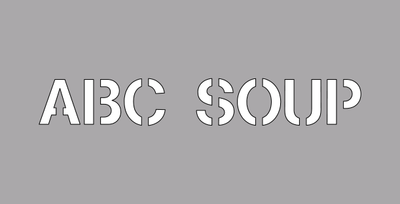
As adults, stencils tend to be more practical than fantastical, but for many people, stencils are something we've used since childhood. They're also something most people have never needed to design themselves and we get a lot of questions about them.
Follow along with our fictional company ABC Soup and learn the 2 most common issues with creating a stencil, how we can address them, and how we can get started on your custom stencil today.
Issue 1 - Bridges & Voids (Or, why doesn't it look like what I sent you?)
Our fictional company ABC Soup sends us over their simple logo that looks like this:
Before we produce any custom sign, especially stencils, we always send the customer a proof. In this case it would look something like this:
This is the point where we get the most questions, namely what did you do to my text/logo? Why are there lines through everything?
Stencils rely on what isn't there (voids) to create your design. If we cut the ABC Soup logo exactly as provided, all the middle bits of the letters would fall out and you'd be left with something that looks like this:
So to get those middle bits to stay in place we have to ensure there are bridges connecting the insides to the outer material. Depending on the size of your stencil these bridges can also have a significant impact on how durable your stencil is. Excessively thin bridges can be prone to snapping, especially if you're using a fuzzy paint roller that can catch on edges.
Script, handwriting,"fancy" fonts, and complex images do not translate well to being stencils. A solid bridge structure, even on parts that don't have fully enclosed "insides" are best when you need a durable stencil that you can reuse many times. Ideally when creating text we use a font that has solid bridges like this.
Issue 2 - Overspray (Or, why is the design so small in the middle?)
As a far cry from our childhood days, its doubtful anyone is tracing their stencil with a pencil. The two most common ways to apply paint through a stencil is to spray it with spray gun or rattlecan, or roll it on with a paint roller. Since we only want paint in the design and not everywhere else, its best to have at least 2 inches or more of overspray room to keep your design clean without having to be a professional painter.
As long as we can address these couple of issues, we can create stencils for all your needs!
Click to request a quote on your custom stencil today!
